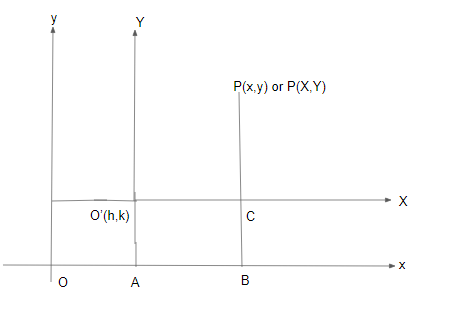
Find the coordinates of the point $P\left( {2,4} \right)$ with respect to the translated axis with origin at $\left( {1,3} \right)$
A. $\left( {1, - 1} \right)$
B. $\left( {1,1} \right)$
C. $\left( { - 1, - 1} \right)$
D. $\left( { - 1,1} \right)$
Answer
577.5k+ views
Hint: We will first consider the random point \[P\left( {x,y} \right)\] and a fixed point \[O'\left( {h,k} \right)\] in the \[X - Y\] plane. As we know that the equations \[X = x - h,Y = y - k\] are called transformation equations and then convert the point \[P\left( {x,y} \right)\] with respect to the new coordinate system\[P\left( {x - h,y - k} \right)\]. As we are given the translated axis origin point so put it equal to\[O'\left( {0 + h,0 + k} \right)\] to determine the values of \[h\] and. Thus, we get the point \[P\left( {x,y} \right)\] and \[P\left( {x - h,y - k} \right)\] by substituting the values.
Complete step by step Answer:
Let $P\left( {x,y} \right)$ be any point in the \[XY\]plane. Let $O'\left( {h,k} \right)$ be the fixed point in \[XY\]plane. We draw two perpendicular axes through$O'$. The $X$-axis is parallel to $x$-axis and $Y$-axis is parallel to $y$-axis. $O'$Is the new origin for \[XY\]plane. The point $P$ has the coordinates$\left( {X,Y} \right)$ with respect to the \[XY\]plane.
Consider the diagram:

Thus the point $P\left( {x,y} \right)$ with respect to the \[XY\]plane is $P\left( {x - h,y - k} \right)$
From the diagram and given in the question:
Translated axis origin is at $O'\left( {1,3} \right)$
Now
The translated point is \[O'\left( {0 + h,0 + k} \right)\]
Now we will put the translated axis origin and the translated point equal to determine the value of $\left( {h,k} \right)$
Thus we get:
$
\Rightarrow O'\left( {0 + h,0 + k} \right) = O'\left( {1,3} \right) \\
\Rightarrow 0 + h = 1 \\
and \\
0 + k = 3 \\
\Rightarrow h = 1 \\
and \\
k = 3 \\
$
Now from the given question, given $\left( {x,y} \right)$ points i.e. $P\left( {x,y} \right)$, put these points in translated point equation i.e. \[O'\left( {0 + h,0 + k} \right)\]
Where
$
h = 1 \\
and \\
k = 3 \\
$
This we get:
Translated points:
$
P'\left( {2 - 1,3 - 4} \right) \\
\Rightarrow P'\left( {1,1} \right) \\
$
Thus we get the translated point as $P'\left( {1,1} \right)$.
The correct option is B.
Note: It’s necessary to construct the diagram for the given question. We have used the concept of transformation of the axis. As we have also found the new coordinate using the old coordinates. We have obtained the value of $h{\text{ and }}k$ to obtain the value of new coordinates.
Complete step by step Answer:
Let $P\left( {x,y} \right)$ be any point in the \[XY\]plane. Let $O'\left( {h,k} \right)$ be the fixed point in \[XY\]plane. We draw two perpendicular axes through$O'$. The $X$-axis is parallel to $x$-axis and $Y$-axis is parallel to $y$-axis. $O'$Is the new origin for \[XY\]plane. The point $P$ has the coordinates$\left( {X,Y} \right)$ with respect to the \[XY\]plane.
Consider the diagram:

Thus the point $P\left( {x,y} \right)$ with respect to the \[XY\]plane is $P\left( {x - h,y - k} \right)$
From the diagram and given in the question:
Translated axis origin is at $O'\left( {1,3} \right)$
Now
The translated point is \[O'\left( {0 + h,0 + k} \right)\]
Now we will put the translated axis origin and the translated point equal to determine the value of $\left( {h,k} \right)$
Thus we get:
$
\Rightarrow O'\left( {0 + h,0 + k} \right) = O'\left( {1,3} \right) \\
\Rightarrow 0 + h = 1 \\
and \\
0 + k = 3 \\
\Rightarrow h = 1 \\
and \\
k = 3 \\
$
Now from the given question, given $\left( {x,y} \right)$ points i.e. $P\left( {x,y} \right)$, put these points in translated point equation i.e. \[O'\left( {0 + h,0 + k} \right)\]
Where
$
h = 1 \\
and \\
k = 3 \\
$
This we get:
Translated points:
$
P'\left( {2 - 1,3 - 4} \right) \\
\Rightarrow P'\left( {1,1} \right) \\
$
Thus we get the translated point as $P'\left( {1,1} \right)$.
The correct option is B.
Note: It’s necessary to construct the diagram for the given question. We have used the concept of transformation of the axis. As we have also found the new coordinate using the old coordinates. We have obtained the value of $h{\text{ and }}k$ to obtain the value of new coordinates.
Recently Updated Pages
Why are manures considered better than fertilizers class 11 biology CBSE

Find the coordinates of the midpoint of the line segment class 11 maths CBSE

Distinguish between static friction limiting friction class 11 physics CBSE

The Chairman of the constituent Assembly was A Jawaharlal class 11 social science CBSE

The first National Commission on Labour NCL submitted class 11 social science CBSE

Number of all subshell of n + l 7 is A 4 B 5 C 6 D class 11 chemistry CBSE

Trending doubts
What is meant by exothermic and endothermic reactions class 11 chemistry CBSE

10 examples of friction in our daily life

One Metric ton is equal to kg A 10000 B 1000 C 100 class 11 physics CBSE

1 Quintal is equal to a 110 kg b 10 kg c 100kg d 1000 class 11 physics CBSE

Difference Between Prokaryotic Cells and Eukaryotic Cells

What are Quantum numbers Explain the quantum number class 11 chemistry CBSE




